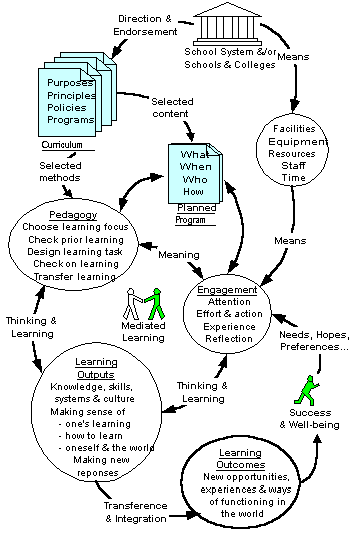![]()
Other topics
Purpose and strategy
In order to be successful we need answers to questions of what, why, who, how, when. A common strategy in large complex endeavours is to develop frameworks that provide answers to these questions.
The answers can be at various levels: principles, guidelines, frameworks, requirements, specifications....
The answers can be provided for various audiences: the community, systems, managers, operators, recipients....
One notion in relation to the curriculum is that it should be one starting point
(for the intended audience) to engage in terms of
– Observation leading to
– Improvement and
– Planning for
– Action (management, teaching & learning)

Several Common Notions of Curriculum
We use and understand the 'word' curriculum in many different ways
• What should be taught by teachers
• What should be learned by students
• A prescription: policy for accountability
• A course of action
• A ‘store’ of possibilities from which to make selections
• A framework for reflection
Different things for different people!!
Translating the Curriculum
Curriculum tends be universal or generic, largely independent of time, place, context and the hopes and needs of the people involved
Teaching and Learning are specific being highly dependent on time, place context and the hopes and needs of the people involved.
Thus there needs to be a 'mechanism' by which curriculum is translated into teaching and learning.
The Curriculum exists
At a range of levels and ‘places’
• National, eg, Mathematics
• The Department’s, eg, NELS, Spaulding
• Published programs, eg, Stop Think Do
• School
• Class (your program)
• Individual
Requires translation from one level to the next!!
Purposes of the curriculum
To help ensure the success of teachers and learners working together,
ie,
• Ensure the long term success and well-being of the learner and
those around him/her
• Meet the needs of the learner in a meaningful and timely fashion.
• Enhance the capacity of the leaner to participate and function in
their world now and in the future.
Authentic curriculum
• Is real to the participants
• Adds value to the quality of life now and in the future
• Benefits the learner and those around him/her
• Has many dimensions, eg, Stop-Think-Do, relaxation, sense of
well-being
• Includes context: purpose, opportunity, methodology…for the
learner
• Results in capabilities that are valued by the people involved
Capabilities

Just as capabilities are multidimensional so are teaching and learning. In order to facilitate the translation of curriculum into effective teaching and learning we need t understand curriculum in its multiple dimensions.
Consider a class ‘Board Game’
• A means to an end?
• A response to a need?
• Something to show for our efforts?
• A meaningful context ?
• Outcomes: social, organisational, cognitive, a product …
• What end? For whom, and how do you know?
Transference of learning
• Is not automatic!!"
• The child’s life is now and in the future so there needs to be transference of learning across time and space
• Intelligence and knowledge should not be confused with maturity: one aspect of maturity is to do with an increased capacity to transfer learning
An Implication
The implication is that there is more than simply delivering the curriculum.
![]()